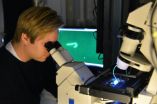(Press-News.org) CAMBRIDGE, MA -- Researchers at MIT and the Santa Fe Institute have found that some widely used formulas for predicting how rapidly technology will advance — notably, Moore's Law and Wright's Law — offer superior approximations of the pace of technological progress. The new research is the first to directly compare the different approaches in a quantitative way, using an extensive database of past performance from many different industries.
Some of the results were surprising, says Jessika Trancik, an assistant professor of engineering systems at MIT. The findings could help industries to assess where to focus their research efforts, investors to pick high-growth sectors, and regulators to more accurately predict the economic impacts of policy changes.
The report is published in the online open-access journal PLOS ONE. Its other authors are Bela Nagy of the Santa Fe Institute, J. Doyne Farmer of the University of Oxford and the Santa Fe Institute, and Quan Bui of St. John's College in Santa Fe, N.M.
The best-known of the formulas is Moore's Law, originally formulated by Intel co-founder Gordon Moore in 1965 to describe the rate of improvement in the power of computer chips. That law, which predicts that the number of components in integrated circuit chips will double every 18 months, has since been generalized as a principle that can be applied to any technology; in its general form, it simply states that rates of improvement will increase exponentially over time. The actual rate of improvement — the exponent in the equation — varies depending on the technology.
The analysis indicates that Moore's Law is one of two formulas that best match actual technological progress over past decades. The top performer, called Wright's Law, was first formulated in 1936: It holds that progress increases with experience — specifically, that each percent increase in cumulative production in a given industry results in a fixed percentage improvement in production efficiency.
To carry out the analysis, the researchers amassed an extensive set of data on actual costs and production levels over time for 62 different industry sectors; these ranged from commodities such as aluminum, manganese and beer to more advanced products like computers, communications systems, solar cells, aircraft and cars.
"There are lots of proposals out there," Trancik says, for predicting the rate of advances in technologies. "But the data to test the hypotheses is hard to come by."
The research team scoured government reports, market-research publications, research reports and other published sources to compile their database. They only used sources for which at least a decade's worth of consistent data was available, and which contained metrics for both the rate of production and for some measure of improvement. They then analyzed the data by using the different formulas in "hindcasting": assessing which of the formulas best fit the actual pace of technological advances in past decades.
"We didn't know what to expect when we looked at the performance of these equations relative to one another," Trancik says, but "some of the proposals do markedly better than others."
Knowing which models work best in forecasting technological change can be very important for business leaders and policymakers. "It could be useful in things like climate-change mitigation," Trancik says, "where you want to know what you'll get out of your investment."
The rates of change vary greatly among different technologies, the team found.
"Information technologies improve the fastest," Trancik says, "but you also see the sustained exponential improvement in many energy technologies. Photovoltaics improve very quickly. … One of our main interests is in examining the data to gain insight into how we can accelerate the improvement of technology."
###
Written by David Chandler, MIT News Office
How to predict the progress of technology
2013-03-07
ELSE PRESS RELEASES FROM THIS DATE:
Iowa State engineers developing ideas, technologies to save the Earth from asteroids
2013-03-07
AMES, Iowa – Bong Wie has heard the snickers.
You want to protect the Earth from asteroids? Where were you when the dinosaurs needed you? You want to be like Bruce Willis in that asteroid movie?
Wie has a serious reply: After five years of science and engineering work, Wie and his small team have a publication list of 40-plus technical papers, $600,000 of NASA research support and a proposal for a $500 million test launch of an asteroid intercept system. Plus, Wie has just been invited to show off his research as part of NASA's Technology Day on the Hill in Washington, ...
INRS overcomes a hurdle in the development of terahertz lasers
2013-03-07
This press release is available in French.
Dr. Roberto Morandotti and his team at the INRS Énergie Matériaux Télécommunications Research Centre have developed a device that is critical to the use of terahertz (THz) sources for a variety of applications. Their electromagnetic non-reciprocal isolator is the subject of a recent article in Nature Communications, showing just how important this new development is. Until now, no isolator existed that was effective in the THz region of the spectrum, a situation that held back the development of certain technologies. The new ...
Star-shaped glial cells act as the brain's 'motherboard'
2013-03-07
The transistors and wires that power our electronic devices need to be mounted on a base material known as a "motherboard." Our human brain is not so different — neurons, the cells that transmit electrical and chemical signals, are connected to one another through synapses, similar to transistors and wires, and they need a base material too.
But the cells serving that function in the brain may have other functions as well. PhD student Maurizio De Pittà of Tel Aviv University's Schools of Physics and Astronomy and Electrical Engineering says that astrocytes, the star-shaped ...
Ketchup turns somersaults
2013-03-07
This press release is available in German.
The unusual behavior of complex fluids is part of our daily life: cake dough climbs up the stirring bar, ketchup becomes liquid when you shake it. Also technology uses such phenomena: if we add a small amount of long-chained polymer molecules, a pipeline can transport more oil. The polymers reduce the flow resistance. But up to now the origin of these effects was unclear. The engineers had to rely on estimates and lengthy trials.
A team of physicists led by Professor Andreas Bausch, Chair of Cellular Biophysics at TUM now ...
Mayo Clinic aids discovery of first dystonia gene found in African-Americans
2013-03-07
JACKSONVILLE, Fla. — A pair of studies tells the tale of how a neuroscientist at Mayo Clinic in Florida helped to discover the first African-American family to have inherited the rare movement disorder dystonia, which causes repetitive muscle contractions and twisting, resulting in abnormal posture. The research may improve diagnosis of this neurological condition in a population not known to suffer from it.
In the first study, published in 2011 in the journal Parkinsonism and Related Disorders, Mayo Clinic's Zbigniew Wszolek, M.D., and a team of neuroscientists from ...
Federal figures miss most work-related amputations
2013-03-07
A new report from Michigan State University and the Michigan Department of Community Health raises significant concerns about the federal government's system for tracking work-related injuries.
Published in the Journal of Occupational and Environmental Medicine, the study found the number of amputations following jobsite accidents in Michigan was nearly two-and-a-half times higher than the official estimate from the U.S. Bureau of Labor Statistics.
Such inaccuracy is evidence that the bureau should change its system that relies solely on a sample of employers to report ...
Protein lost in tumors blocks normal cells from being reprogrammed into stem cells
2013-03-07
Researchers from the Icahn School of Medicine at Mount Sinai have discovered that a particular protein prevents normal cells from being reprogrammed into cells that resemble stem cells, providing new insight into how they may lose their plasticity during normal development. This finding has broad-reaching implications for how cells change during both normal and disease development. The data are published this week in Nature Communications.
In a previous study, Emily Bernstein, PhD, and her team at Mount Sinai studied the natural progression of melanoma using mouse and ...
Researchers explain a key developmental mechanism for the first time in plants
2013-03-07
Cold Spring Harbor, NY -- The normal development of an animal or plant can be compared in at least two ways with the successful performance of a great symphony. The whole is the product of a great number of events involving contributions by many different "players"; and these contributions must occur in a precise and almost perfectly coordinated temporal and spatial sequence.
In simple animals like the fruit fly and more recently in plants and mammals, scientists have been able to identify some of the principal players in the developmental symphony. Today, a team ...
UTHealth researchers report prevalence of sexting among minority youth
2013-03-07
HOUSTON—(March 6, 2013)—Researchers at The University of Texas Health Science Center at Houston (UTHealth) have found that up to 30 percent of minority youths reported sending or receiving "sexts," which are sexually explicit messages sent through technology including photos, videos and text-only messages.
"Although sexting is relatively common among youth and there has been a lot of attention about sexting in the media, there hasn't been much about sexting among ethnic minority youth," said lead investigator Melissa Fleschler Peskin, Ph.D., assistant professor of behavioral ...
A sausage a day is too many
2013-03-07
This press release is available in German.
"We estimate that three percent of all premature deaths can be attributed to the high consumption of processed meat," summarizes Sabine Rohrmann from the Institute of Social and Preventive Medicine at the University of Zurich. Teaming up with research colleagues from ten countries, she has been studying the link between the consumption of processed meat and the risk of mortality as part of a Europe-wide study with around 450,000 participants.
People who eat a lot of processed meat such as sausage products, salami or ham ...


